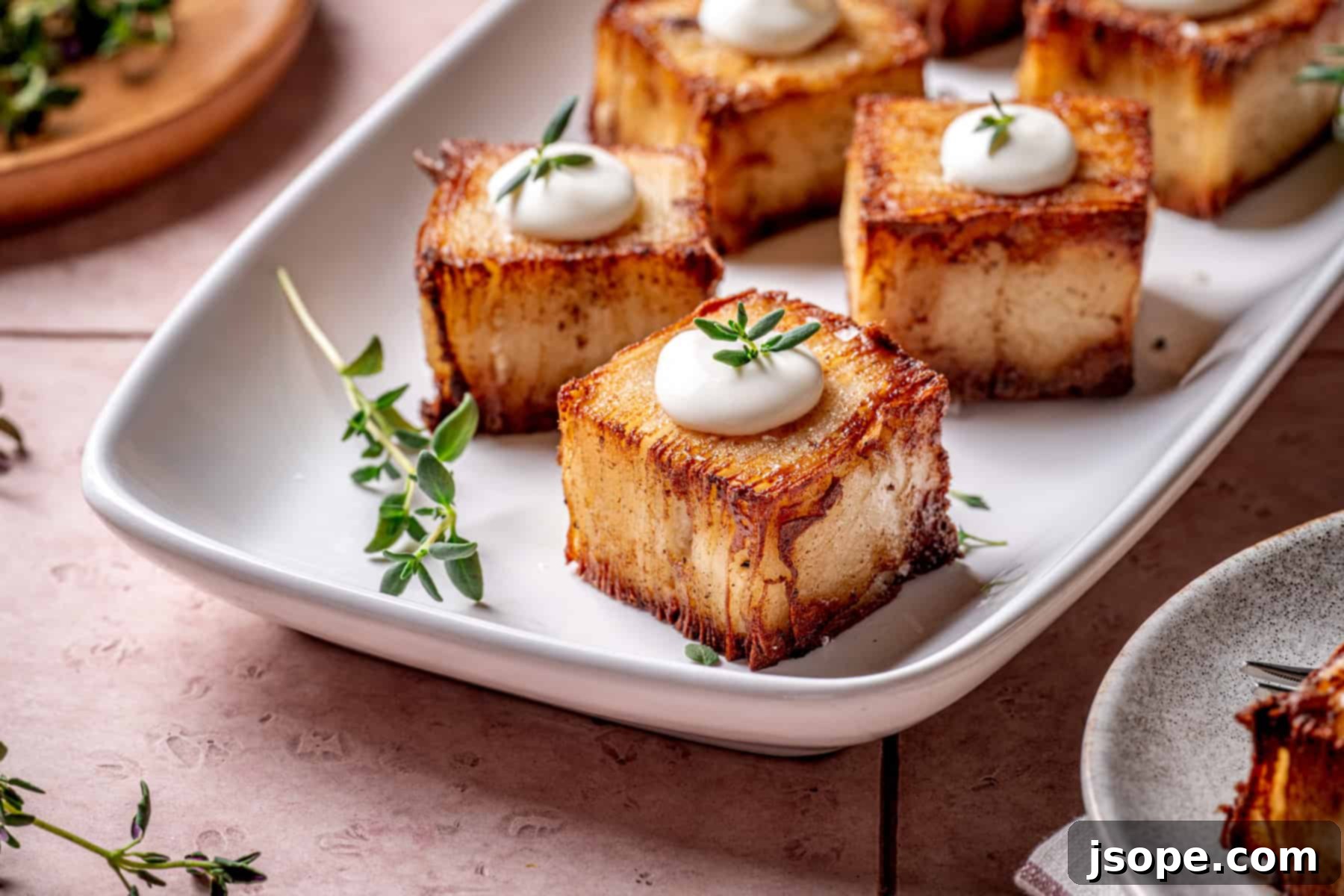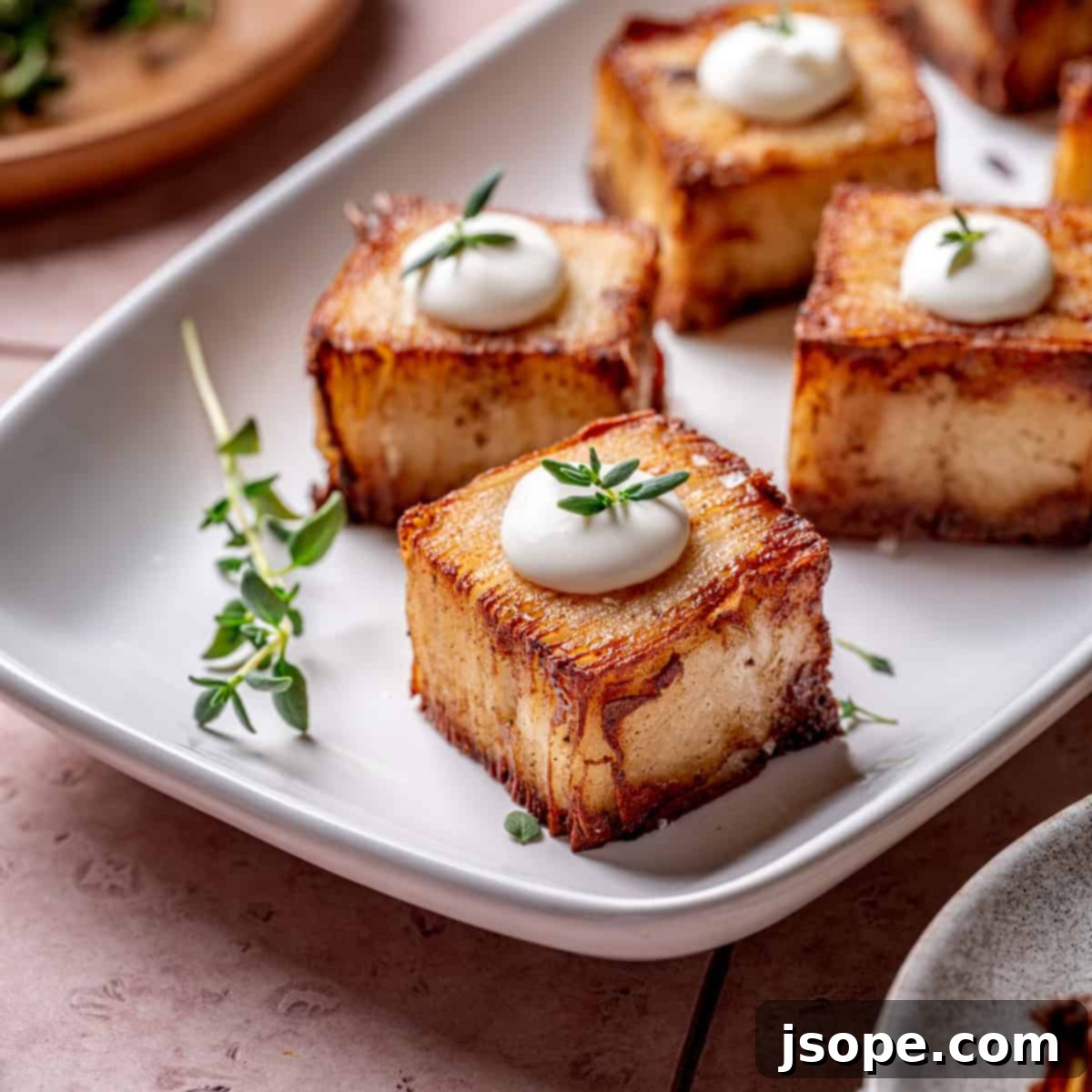Prepare to be enchanted by a culinary masterpiece that has captivated palates worldwide: the **Potato Pavé**. This French delicacy, an exquisite play on traditional potato dishes, has soared in popularity over the past decade and a half. And for superb reasons! It’s a dish that embodies elegance, offers stunning visual appeal, and delivers an intriguing complexity of flavors and textures. Most importantly, it’s utterly delicious!
While mastering the Potato Pavé does require a certain investment of time and effort, much of the process is hands-off. For optimal results, it’s ideally prepared the day before serving, allowing the flavors to meld and the structure to set perfectly. If you’re on a quest for a truly showstopping potato dish—one that will impress guests and elevate any meal—this **Garlic Parmesan Potato Pavé** is undeniably it! Imagine layers of thinly sliced potatoes, infused with rich butter, decadent cream, savory Parmesan cheese, and aromatic garlic confit. The result is a spectacular culinary treat: irresistibly crispy on the outside, giving way to an incredibly creamy, tender interior. This sophisticated side dish is not only a delight to behold but also surprisingly achievable in your home kitchen.
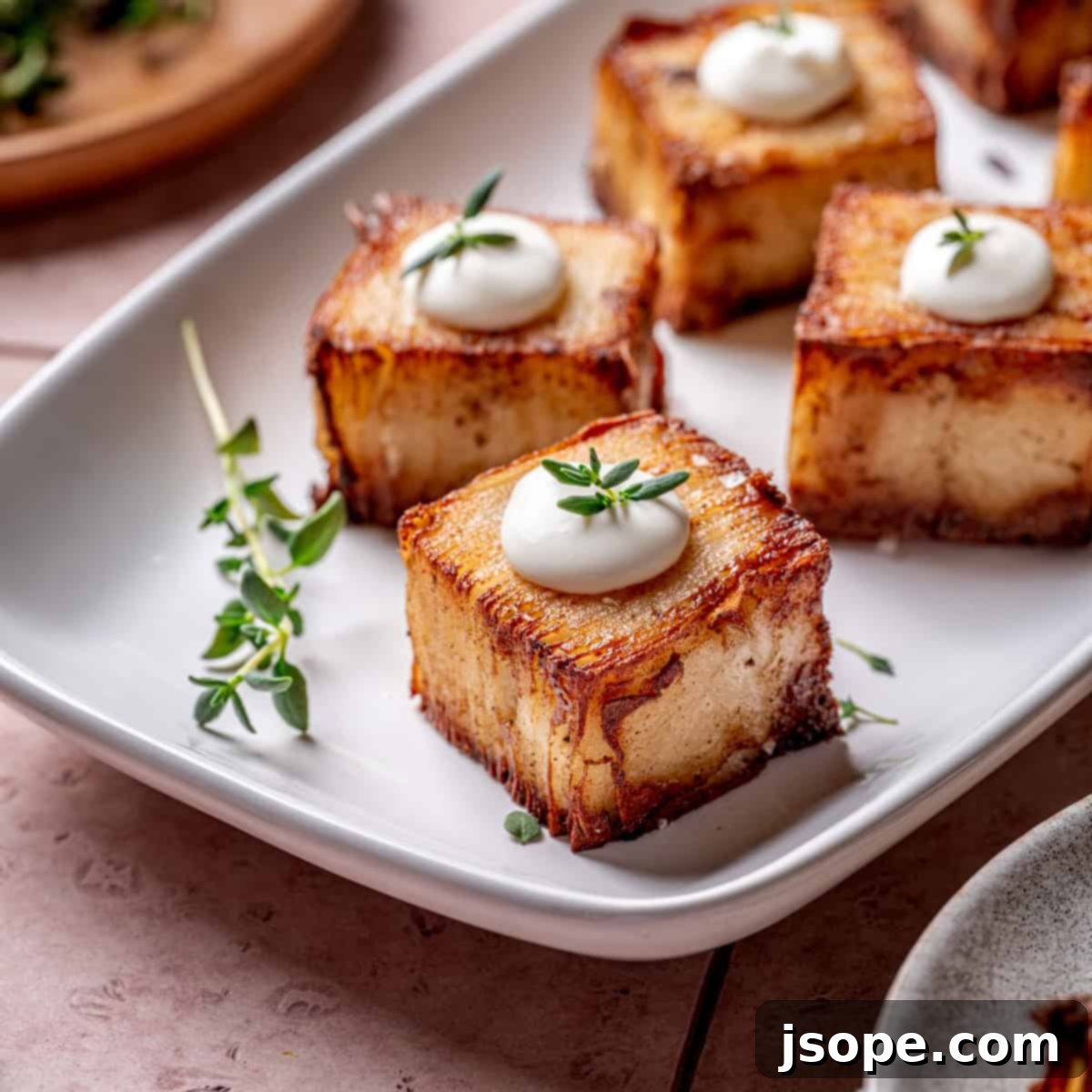
Craving more sophisticated potato creations? Be sure to explore our recipe for Garlic Rosemary Fondant Potatoes, another fantastic way to transform humble potatoes into an extraordinary side.
Why You’ll Adore This Garlic Parmesan Potato Pavé Recipe
This Garlic Parmesan Potato Pavé isn’t just a recipe; it’s an experience. Here’s why it’s destined to become a beloved staple in your culinary repertoire, especially for special occasions:
- Effortless Elegance: While it demands some preparation, a significant portion of the cooking time is hands-off, leaving you free to focus on other aspects of your meal or simply relax. The actual work involved in layering is meditative and rewarding.
- The Pinnacle of Potato Perfection: Widely regarded by many food enthusiasts as one of the best potato dishes in the world, its unique combination of textures and flavors truly sets it apart. It transforms the humble potato into a luxurious delicacy.
- Impressive Presentation: With its beautifully defined layers and golden-crisp exterior, Potato Pavé offers an inherently fancy presentation. It effortlessly elevates a simple potato side dish into sheer indulgence, making it ideal for dinner parties, holidays, or any meal where you want to make a statement.
- Incredibly Versatile: These elegant potato blocks pair harmoniously with almost any main course, from a succulent roasted chicken to a prime cut of steak, or even a delicate fish. Its rich yet balanced flavor profile makes it a universal crowd-pleaser.
- Convenience of Make-Ahead & Freeze: For ultimate convenience, Potato Pavé can be prepared well in advance and frozen. This feature makes it a perfect option for holiday meal planning or for those times when you need an impressive side dish without the last-minute fuss. Simply defrost, slice, and pan-fry when ready to serve!
What Exactly is Potato Pavé (or Potato Terrine)?
It comes as no surprise that this sophisticated dish originates from France, a nation renowned for its culinary innovation. The term “pavé” in French literally translates to “paving stones” or “cobblestones.” This name beautifully describes the dish’s signature appearance: precisely cut, rectangular blocks of layered potatoes, much like the charming stone streets of European cities.
Potato Pavé gained considerable recognition in the United States, notably popularized by world-renowned chef Thomas Keller during his appearances on the Martha Stewart show. However, variations of this elegant “potato terrine” have been cherished throughout France for centuries. At its heart, Potato Pavé involves ultra-thinly sliced starchy potatoes, traditionally Russets, which are carefully soaked in heavy cream. This initial soak not only prevents browning but also begins the infusion of creamy richness that defines the dish.
The magic unfolds as these delicate potato slices are meticulously layered within a baking pan, with each layer generously seasoned. Our recipe features a delightful blend of salt, black pepper, small dots of butter, fragrant garlic confit, and a generous sprinkling of freshly grated Parmesan cheese. Once assembled, this potato loaf is slowly baked until tender and cooked through. The crucial next step, which differentiates it from many other layered potato dishes, is compression. As the pavé cools, it is weighted down, then chilled in the refrigerator, ideally overnight. This compression process fuses the layers together, creating a dense, cohesive block that holds its shape beautifully. The following day, the chilled pavé is cut into individual smaller pieces—typically squares or rectangles—and then shallow-fried in clarified butter until each side boasts a deep golden-brown hue and an irresistibly crispy texture. The result is a truly stunning, rich, and incredibly creamy treat that truly melts in your mouth!
We love to crown our Potato Pavé with a dollop of cool, tangy crème fraîche and a scattering of fresh herbs, like delicate thyme sprigs, for a burst of freshness and a touch of color. For those seeking to truly elevate the experience and create an unforgettable impression, a tiny spoonful of high-quality caviar adds an extraordinary layer of luxury and sophistication. It’s a guaranteed conversation starter and a dish your guests will remember long after the meal is over!
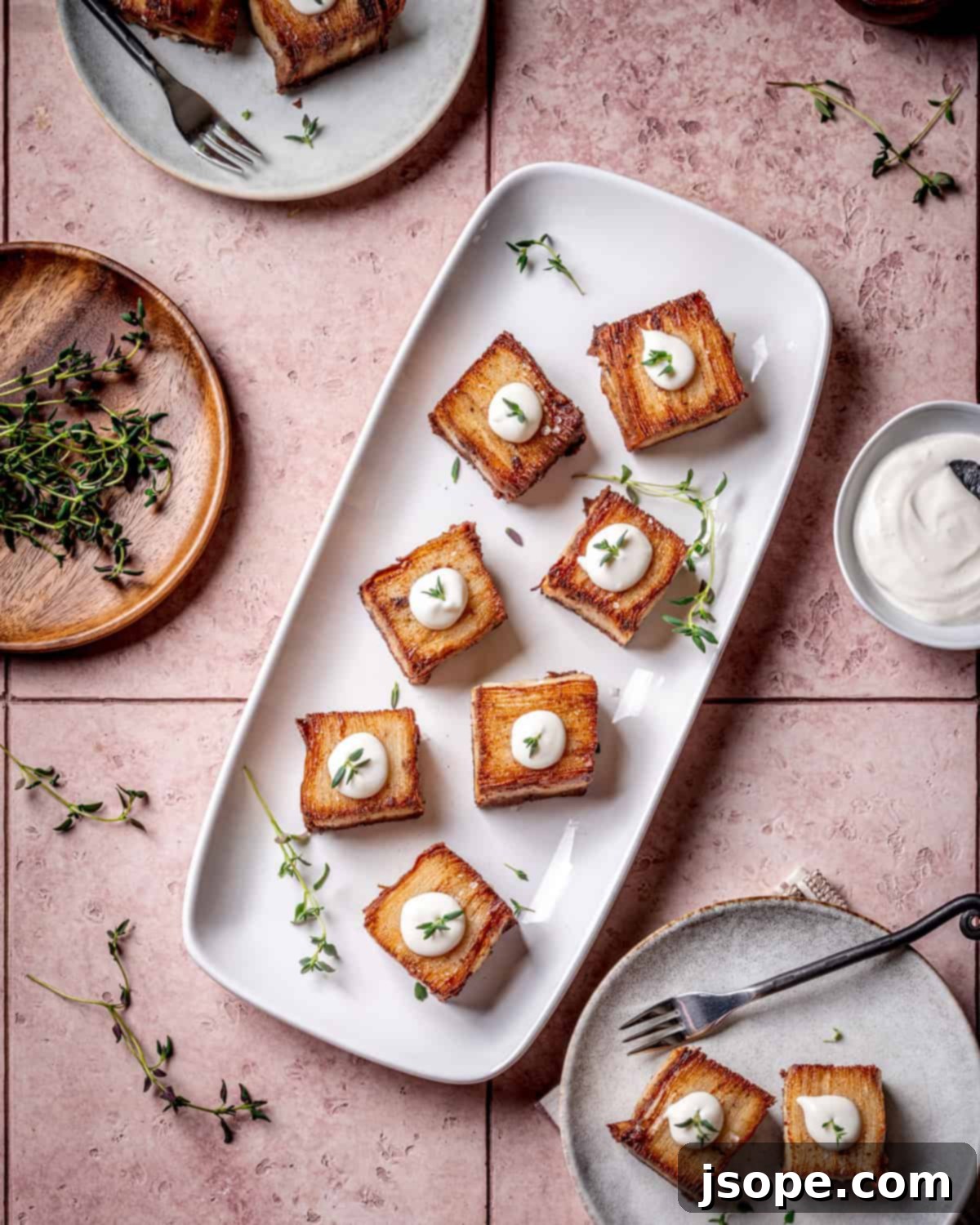
Essential Ingredients for Your Perfect Potato Pavé
Crafting this incredible Potato Pavé requires a selection of high-quality ingredients. Each component plays a vital role in achieving the dish’s signature rich flavor and luxurious texture. Here’s a detailed look at what you’ll need:
- Heavy Cream: This is fundamental. The thinly sliced potatoes are submerged in heavy cream prior to layering, which serves a dual purpose: preventing the potatoes from oxidizing and browning, and allowing them to soak up a significant amount of the cream’s richness, contributing to the incredible tenderness and flavor of the finished dish.
- Potatoes: For the classic Potato Pavé, **Russet potatoes** are undeniably the superior choice. Their high starch content is crucial for the layers to bind together beautifully during baking and compression, resulting in that perfectly dense yet creamy interior. They are also readily available in most grocery stores.
- Unsalted Butter: We advocate for unsalted butter. This allows you complete control over the seasoning of your dish, ensuring the perfect balance of salt without inadvertently making it too salty. Butter is incorporated between layers to enhance richness and promote browning during the final fry.
- Kosher Salt & Freshly Ground Black Pepper: Proper seasoning is key in a dish with so many layers. Kosher salt provides a clean, pure saltiness, and freshly ground black pepper adds a subtle warmth and aromatic depth.
- Garlic Confit: This ingredient is a game-changer, infusing the pavé with a deep, mellow garlic flavor without any harshness. Garlic confit is incredibly easy to make at home (you can find our simple stovetop recipe HERE), and its soft, buttery texture integrates beautifully into the potato layers.
- Parmesan Cheese: For the best flavor, insist on **Parmigiano Reggiano**. Freshly grating it just before use ensures maximum flavor and avoids the often-chalky texture and muted taste of pre-grated varieties. The sharp, nutty notes of Parmesan add a delightful umami depth to each layer.
- Clarified Butter: This is essential for the final pan-frying step. Clarified butter, or ghee, is pure butterfat, meaning the milk solids and water have been removed. This allows it to be heated to a higher temperature without burning, ensuring a beautiful golden, crispy crust on your pavé without any bitter, burnt notes. It imparts a wonderful buttery flavor that regular butter cannot achieve in this context. You can often find clarified butter or ghee in most grocery stores or easily make your own.
- Crème Fraîche: A small dollop of crème fraîche served alongside the finished pavé adds a bright, tangy counterpoint to the richness of the potatoes. Its cool, slightly sour creaminess provides a refreshing balance, elevating the overall taste experience.
Refer to the recipe card below for precise quantities and detailed measurements to ensure your Potato Pavé turns out perfectly.
Smart Substitutions for Potato Pavé Ingredients
While the ingredients listed above are ideal for achieving the best Potato Pavé, sometimes dietary needs or availability call for substitutions. Here are some reliable alternatives that will still yield delicious results:
- Garlic Confit: If garlic confit isn’t an option, you can certainly use finely minced sautéed garlic to achieve a similar aromatic base. For a sharper, more pungent garlic kick, a very small amount of raw, grated garlic could be used, though be mindful not to overpower the delicate potato flavor. However, the mellow sweetness of confit garlic is truly perfect for this recipe.
- Parmesan Cheese: For a delightful cheesy flavor, good substitutes for Parmigiano Reggiano include Pecorino Romano (which will offer a saltier, tangier profile) or Grana Padano (a slightly milder, sweeter alternative).
- Crème Fraîche: A high-quality sour cream can be an excellent substitute for crème fraîche. It offers a similar tangy creaminess that beautifully complements the rich potato pavé.
- Clarified Butter: Ghee is virtually identical to clarified butter and works just as wonderfully for pan-frying. If you need a dairy-free option or prefer a lighter flavor, a neutral, high-smoke-point oil such as avocado oil or grapeseed oil can be used. Keep in mind, however, that these oils will not provide the characteristic buttery flavor that clarified butter or ghee imparts to the crispy crust.
The Art of Crafting Potato Pavé: A Step-by-Step Overview
Creating Potato Pavé is truly an culinary adventure, and while it’s not a dish you “whip up” on a busy Tuesday night, the effort is profoundly rewarding. The process begins with the careful preparation of the potatoes, which are peeled and then sliced incredibly thinly using a mandolin—aim for potato chip-like transparency. These delicate slices are immediately immersed in heavy cream, which prevents browning and starts the flavor infusion.
Next, the potatoes are meticulously layered in a parchment paper-lined pan. Each couple of layers is seasoned with a sprinkle of kosher salt and black pepper, small dots of unsalted butter, creamy garlic confit, and a generous dusting of grated Parmesan cheese. This layering continues until the pan is full, building the terrine. Once assembled, the pavé is covered and baked slowly in the oven, allowing the potatoes to become incredibly tender and the flavors to meld beautifully. After baking, the dish is cooled, and then comes the critical step of compression. A weighted object, such as another loaf tin filled with heavy cans, is placed on top, and the pavé chills in the refrigerator overnight. This compression binds the layers tightly, creating a dense, firm block that can be cleanly sliced.
The following day, the firm potato loaf is removed from its pan, trimmed for perfect edges, and then cut into uniform cubes or rectangular pieces. These individual pieces are then pan-fried in hot clarified butter until each cut side develops a gloriously golden-brown, irresistibly crispy exterior. This final frying step transforms the tender, creamy interior into a textural marvel, offering a delightful contrast that makes Potato Pavé truly unforgettable.
Essential Equipment for Potato Pavé Success
Having the right tools makes all the difference when preparing Potato Pavé. Here’s a list of key equipment to ensure smooth sailing and perfect results:
- Mandolin Slicer: This is arguably the most crucial piece of equipment. Achieving consistent, paper-thin potato slices (think potato chip thin) is paramount for the pavé’s structure and texture. A mandolin ensures uniformity that is difficult to achieve with a knife, allowing the layers to fuse seamlessly.
- Loaf Pan or High-Sided Baking Dish: You’ll need a sturdy, high-sided pan to bake and compress the potatoes. We recommend a ⅓ hotel pan measuring 13x7x2 ½ inches, which holds approximately 2 ⅓ quarts and creates perfect pavé dimensions. Alternatively, an 8x8x3 inch or 9x9x2 inch square baking dish will also work effectively. The high sides are necessary to accommodate the numerous layers and the weight for compression.
- Parchment Paper: Essential for lining your baking pan. It provides a non-stick surface, making it incredibly easy to lift the entire cooked and compressed potato pavé out of the pan without sticking or crumbling. Ensure you leave enough overhang to act as “handles.”
- Nonstick Cooking Spray: A quick spray before lining with parchment paper helps the paper adhere to the sides and bottom of the pan, preventing it from shifting as you layer the potatoes.
- Aluminum Foil: Used to tightly cover the baking dish during the initial baking phase. This ensures the potatoes steam and cook through evenly while staying moist, preventing the top layers from drying out or over-browning.
- Large Sauté Pan: For the final, glorious step of crisping up the individual pavé pieces. A spacious sauté pan allows you to fry several pieces at once without crowding, ensuring a golden, crunchy exterior on all sides.
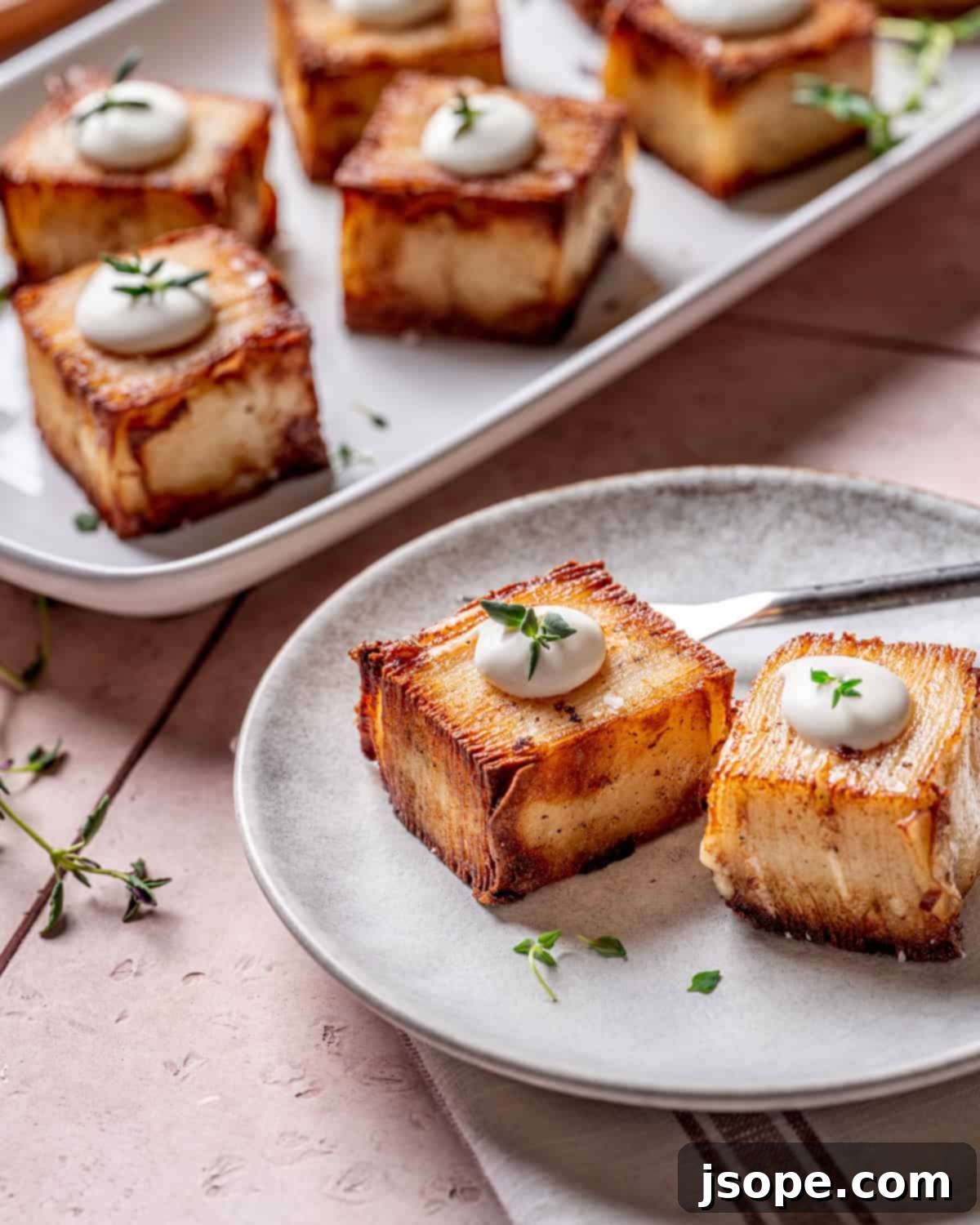
Detailed Step-by-Step Instructions to Master Potato Pavé
Follow these precise steps to create a Garlic Parmesan Potato Pavé that is sure to impress:
1. Prepare the Potatoes
- Pour the heavy cream into a large, wide bowl. Peel your Russet potatoes thoroughly. If necessary, trim the ends of the potatoes to create flat surfaces that fit securely on your mandolin. With extreme caution, using a mandolin, slice the potatoes into paper-thin disks—they should be almost transparent, similar to a potato chip. As soon as each potato slice is made, immediately submerge it into the bowl of heavy cream. This prevents oxidation (browning) and ensures the potatoes begin absorbing the rich cream flavor.
2. Assemble the Pavé
- Lightly spray the inside of your chosen baking dish or loaf pan with nonstick spray. Carefully line the dish with parchment paper, ensuring you leave a generous few inches of overhang on all sides. This overhang will serve as handles later for easy removal. Spread about one tablespoon of softened unsalted butter in a thin, even layer over the parchment paper, covering the bottom and sides.
- Begin assembling the layers: Take potato slices directly from the cream (don’t rinse or dry them) and shingle them, slightly overlapping, to create a solid couple of layers across the bottom of the pan. Now, add your first seasoning layer: distribute a few small, pea-sized pieces of unsalted butter evenly over the potatoes. Next, spoon several cloves of crushed garlic confit across the layer. Finish with a light, even sprinkle of freshly grated Parmesan cheese, kosher salt, and black pepper. Repeat this process, adding another couple of layers of potatoes, followed by butter, garlic confit, Parmesan, salt, and pepper. Continue layering until all the potato slices are used, or the baking dish is filled to the top, ensuring the final layer is seasoned.
3. Bake, Compress, and Cool
- Preheat your oven to 350°F (175°C). Once the layering is complete, carefully fold the excess parchment paper over the top of the potatoes to cover them. Then, cover the entire baking dish tightly with aluminum foil, crimping the edges to seal securely. Place the dish in the preheated oven and bake for 2 hours.
- After the baking time, remove the dish from the oven. Keep it covered with the foil and parchment, and let it cool undisturbed at room temperature for approximately one hour. This allows the internal heat to redistribute and the layers to begin setting.
- For the crucial compression step: Once cooled for an hour, place another loaf tin or a flat, sturdy object (such as a piece of cardboard or wood cut to fit perfectly) directly on top of the foil covering the potatoes. Then, add something heavy to weigh it down—canned goods, a brick wrapped in foil, or even another heavy baking dish work perfectly. Transfer the weighted pavé to the refrigerator and chill overnight (at least 8-12 hours). This compression is vital for creating the dense, sliceable block.
4. Cut and Fry the Pavé
- Once the potato pavé has rested and compressed thoroughly overnight, remove the weights and the foil covering. Gently open the parchment paper and use the overhang to carefully pull the entire potato pavé block from the baking dish. Transfer it to a clean cutting board. For a perfectly clean and elegant presentation, use a sharp knife to trim off any uneven edges. Now, cut the large potato block into your preferred serving sizes—squares or rectangles, as depicted in the photos, are classic choices.
- Heat the clarified butter in a large sauté pan over medium-high heat until shimmering. You will likely need to fry the pavé in batches to avoid crowding the pan, which would prevent crisping. Add some of the potato pavé pieces to the hot butter, ensuring a cut side is facing down. Pan-fry until that side turns a beautiful golden brown and becomes wonderfully crispy. Carefully flip and fry the other cut sides until similarly golden and crisp. Finally, briefly fry the top and bottom surfaces for just a few seconds each to ensure even crispness.
- Remove the pan-fried pavé pieces from the butter and transfer them to a wire rack set over a baking sheet (or directly onto a paper towel-lined plate to absorb excess oil). If serving multiple batches, you can keep the finished pieces warm in a low oven (around 180°F or 80°C) until all pieces are fried and you’re ready to serve. Garnish with a small dollop of cool crème fraîche and a sprig of fresh thyme for a touch of elegance and contrasting flavor.
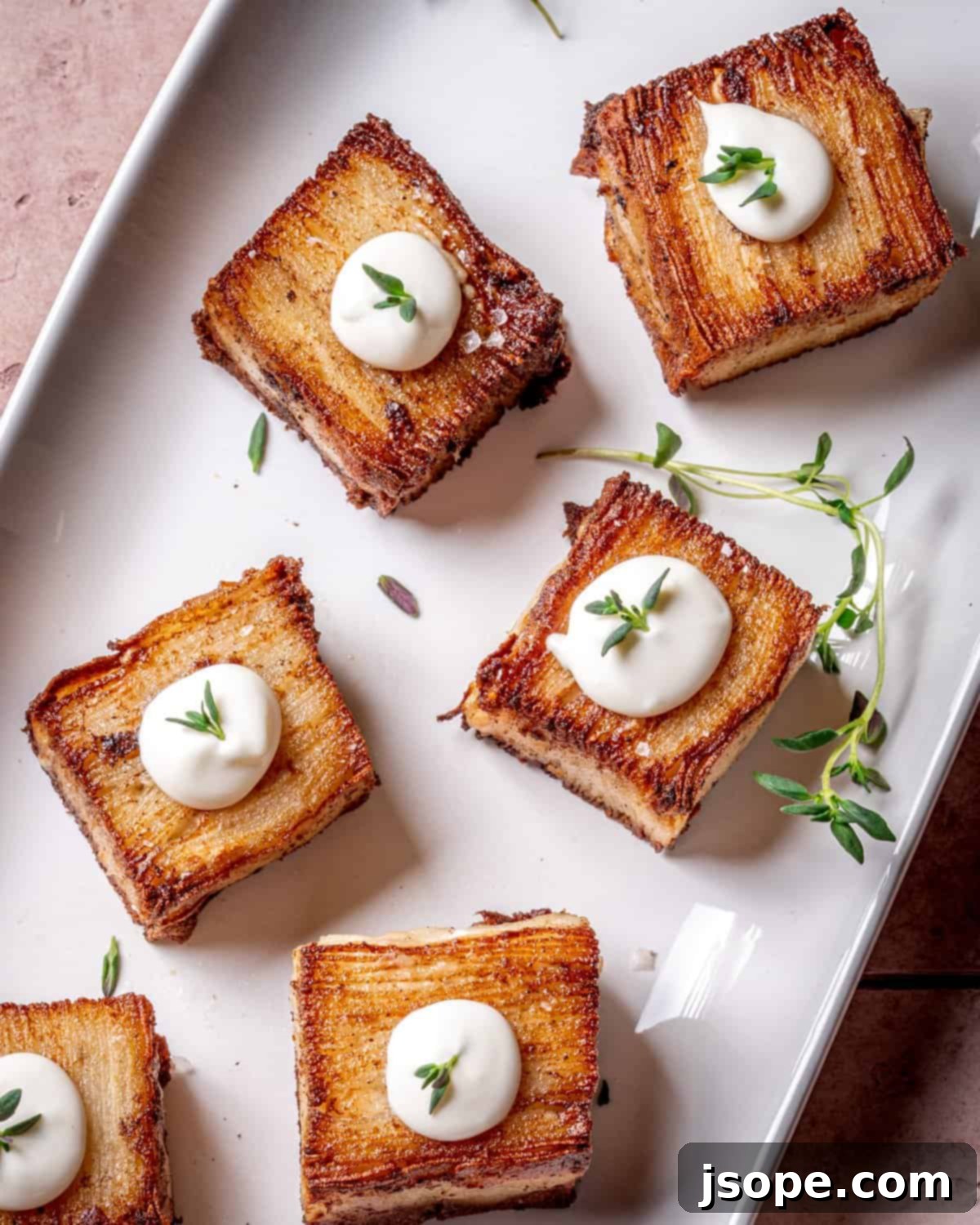
Creative Variations for Your Potato Pavé
While the classic Garlic Parmesan Potato Pavé is a showstopper on its own, don’t hesitate to experiment with these delicious variations to suit different tastes or occasions:
- Sweet Potato Pavé: For a delightful twist, substitute some or all of the Russet potatoes with sweet potatoes. This will introduce a lovely sweetness and vibrant color, offering a different flavor profile that pairs wonderfully with savory meats like pork or turkey. Adjust seasoning to complement the sweet notes.
- Herbaceous Pavé: Infuse your pavé with a different blend of herbs. Beyond thyme, consider finely chopped rosemary, sage, or chives added to the layering process for an extra aromatic dimension. You can also infuse the heavy cream with herbs by gently warming it with herb sprigs before soaking the potatoes.
- Spicy Kick: For those who enjoy a little heat, a pinch of red pepper flakes or a thin layer of finely minced jalapeño (seeds removed for less heat) can be added between potato layers for a subtle, warming spice.
- Cheese Varieties: Experiment with different cheeses! Gruyere offers a nutty, complex flavor, while a sharp cheddar could provide a bolder, more robust taste. For a luxurious touch, a hint of truffle cheese could be exquisite.
- Presentation Perfection: Beyond squares and rectangles, consider using a round cookie cutter or ring mold to create individual, perfectly round pavé portions for an extra elegant presentation. You can also cut larger pieces, perhaps 5″x5″ squares, for a more substantial side.
Storage Solutions for Potato Pavé
One of the many benefits of Potato Pavé is its excellent make-ahead and storage capabilities, making it perfect for entertaining or enjoying leftovers.
How to store leftover potato pavé:
- Once cooked and cooled, any leftover Potato Pavé pieces should be stored in an airtight container in the refrigerator. They will maintain their quality and deliciousness for up to 5 days.
How to reheat leftover potato pavé:
- To enjoy your pavé again, simply reheat the pieces in a preheated oven at 350°F (175°C) for about 15 minutes, or until they are thoroughly warmed through and the exterior is crisp once more. Avoid microwaving, as it can make them soggy.
Can you freeze leftover potato pavé?
- Absolutely! Potato Pavé freezes exceptionally well. Place cooked, cooled, and cut pieces in an airtight, freezer-safe container, separating layers with parchment paper to prevent sticking. They can be frozen for up to 4 months. When ready to serve, transfer them to the refrigerator to defrost overnight before reheating as directed above. This makes it an ideal option for advance meal preparation!
Top Tips for Unforgettable Potato Pavé
Achieve potato perfection with these expert tips and tricks:
- Pre-Frying Freezing for Ultimate Convenience: You can freeze the entire potato pavé block (after it has been weighted and refrigerated overnight, but before cutting and frying). This is a fantastic way to prepare well in advance for a special occasion. When you’re ready to serve, simply defrost the block in the refrigerator, then proceed to cut and pan-fry the individual pieces as per the instructions. This allows for maximum flexibility in your cooking schedule.
- DIY Crème Fraîche: For fresh, homemade crème fraîche, combine 8 parts heavy cream with 1 part cultured buttermilk in a clean jar or container. Stir well, cover loosely, and leave it out on your kitchen counter at room temperature overnight, or until it visibly thickens and sets to a yogurt-like consistency. Once thickened, refrigerate it. This homemade version often has a richer, tangier flavor than store-bought varieties.
- Mandolin Safety First: Always use the safety guard that comes with your mandolin to protect your fingers. Potato pavé requires very thin slices, and a mandolin can be dangerous if not used properly. Consider wearing a cut-resistant glove for extra protection.
- Consistent Potato Slices: The thinner and more uniform your potato slices, the better your pavé will hold together and cook evenly. This consistency is key to achieving that beautiful layered look and melt-in-your-mouth texture.
- Don’t Skimp on Compression: The overnight compression step is non-negotiable. It’s what binds the layers, expels excess moisture, and creates the firm, cohesive block that can be neatly cut and fried. Patience here pays off immensely.
Common Troubleshooting for Potato Pavé
While Potato Pavé is quite forgiving, a couple of issues might arise during the final frying step. The most common concern is that small flaky pieces of potato pavé might break off into the pan while frying. If these small bits are left in the clarified butter as you fry subsequent batches, they will quickly burn. Burnt potato fragments can impart an unpleasant, bitter flavor to your otherwise delicious clarified butter and, consequently, to the remaining pavé pieces. To avoid this, it’s highly recommended to use a fork or a small slotted spoon to carefully remove any flaky, browned pieces from the clarified butter between each batch of frying. This simple step ensures every piece of your Potato Pavé achieves a clean, buttery, and perfectly crispy finish without any bitterness.
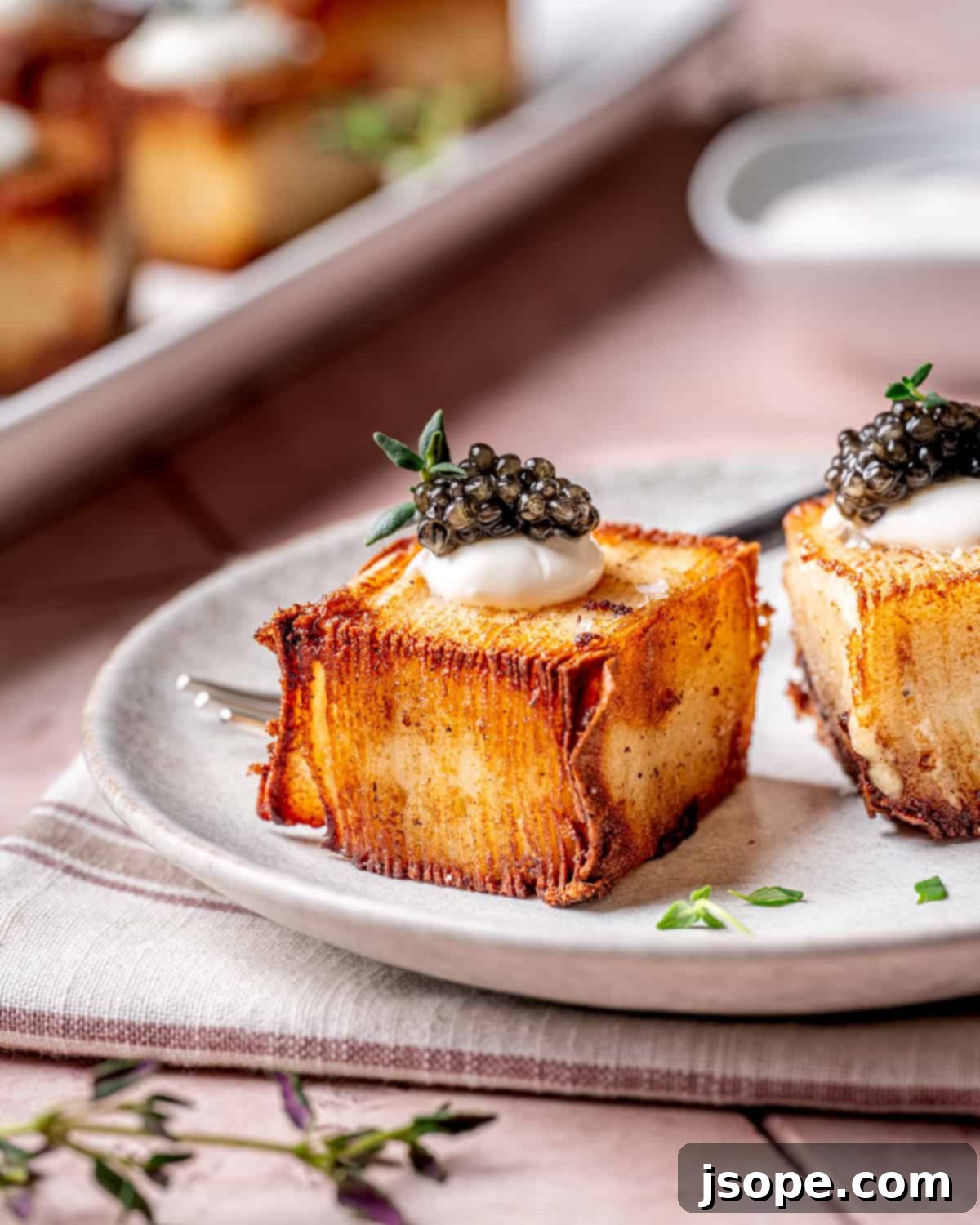
What to Serve with Your Elegant Potato Pavé
The versatility of Potato Pavé makes it an exceptional accompaniment to a wide array of main courses. Its rich and creamy texture provides a luxurious counterpoint to almost any protein. A beautifully seared steak, such as a Parmesan-crusted filet mignon, works perfectly with this fancy side dish, creating an undeniably opulent meal. We particularly adore serving Potato Pavé as an elevated alternative to traditional fries alongside Steak Frites, transforming this classic French bistro dish into an even more refined experience.
Beyond beef, these layered potatoes are a magnificent choice for holiday spreads, complementing a succulent roasted beef tenderloin, a flavorful rack of lamb, or an Herb-crusted Pork Tenderloin. For a truly trendy and ultra-fancy presentation, consider serving your Potato Pavé with a dollop of crème fraîche topped with a luxurious spoonful of caviar. If we’re aiming for an over-the-top potato dish, we frequently reach for Royal Baika caviar or a similar high-quality option to adorn these impressive layered potatoes.
Perfect Wine Pairings for Potato Pavé
Choosing the right wine to accompany your Potato Pavé largely depends on the main protein you’re serving alongside it. However, if the Potato Pavé is the star of the show, or if you’ve elevated it with a luxurious topping like caviar, sparkling wine or Champagne makes for an exquisite pairing. Their crisp acidity and effervescence beautifully cut through the richness of the potatoes and complement the briny notes of caviar, creating a truly celebratory experience.

Frequently Asked Questions About Potato Pavé
Potato Pavé is a classic French creation, a refined variation of traditional scalloped potatoes. While it has deep roots in French cuisine, its modern popularity in the US can be largely attributed to chef Thomas Keller, who showcased it to a wider audience.
While you technically *can* use a neutral oil to crisp up the potatoes, clarified butter or ghee are by far the superior choices. They impart a rich, authentic buttery flavor, and crucially, they prevent the bitter taste that can arise from burnt milk solids when using regular butter at high frying temperatures. For the best flavor and a perfectly golden crust, clarified butter or ghee is highly recommended.
The primary distinction lies in the preparation and final structure. Scalloped potatoes are typically baked in a creamy sauce and served directly from the dish; they are not compressed. This results in a softer, creamier potato dish that doesn’t maintain its shape when cut. Potato Pavé, on the other hand, is baked, then heavily compressed overnight, which binds the thin layers into a firm, cohesive block. This allows it to be cut into distinct, elegant pieces and then pan-fried for a crispy exterior, a characteristic impossible with traditional scalloped potatoes.
While some potatoes might work, Russet potatoes are highly recommended for Potato Pavé. Their high starch content is crucial for the layers to bind together properly during baking and compression, creating the desired firm yet creamy texture. Waxy potatoes, like Yukon Golds, have less starch and may result in a pavé that doesn’t hold its shape as well.
Potato Pavé is not inherently difficult, but it requires patience and attention to detail rather than complex techniques. The slicing, layering, and especially the compression step are key. While it’s not a quick recipe, much of the time is hands-off. A beginner with a keen eye for detail and a mandolin can certainly achieve fantastic results.
More Irresistible Side Dishes You’ll Love
Looking for other delightful recipes to complement your meals? Try these:
- Jalapeño Spinach Artichoke Dip Recipe
- Summer Farro Salad with Zucchini Asparagus and Feta
- White Wine Garlic Butter Sautéed Oyster Mushrooms
- Italian Herb Sautéed Zucchini Squash Recipe
Perfect Main Course Pairings
These are our favorite main dishes that beautifully complement the richness of Potato Pavé:
- Parmesan Crusted Filet Mignon with Truffle Cream Sauce
- Steak Frites with Easy Red Wine Pan Sauce
- Mustard Crusted Rack of Lamb
- Bone-In Veal Milanese Recipe (Cotoletta alla Milanese)
📖 Recipe
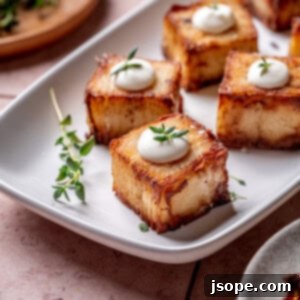
Garlic Parmesan Potato Pavé Recipe with Crème Fraîche
Pin Recipe
Equipment
- Mandolin Slicer for achieving those essential paper-thin potato slices.
- Loaf Pan or similar high-sided square/rectangular pan for baking and compressing the potatoes.
- Parchment Paper to line the loaf pan for easy removal.
- Nonstick Spray to help the parchment paper adhere to the pan.
- Aluminum Foil to cover the potatoes securely while baking.
- Large Sauté Pan for crisping the pavé in clarified butter before serving.
Ingredients
- 2 cups heavy cream
- 4 large Russet potatoes
- 4 Tablespoons unsalted butter divided
- 2 Tablespoons kosher salt
- 2 teaspoons black pepper
- 15 cloves garlic confit
- ½ cup grated Parmesan cheese
- ½ cup clarified butter or ghee
- Créme fraîche for garnish
Instructions
Prepare the Potatoes
- Add the heavy cream to a large bowl. Peel the potatoes and trim them as needed to fit your mandolin. Carefully, using a mandolin, slice the potatoes very thinly—they should be transparent like potato chips. Immediately place the sliced potatoes into the bowl of cream to prevent browning.2 cups heavy cream, 4 large Russet potatoes
Assemble the Pavé
- Spray your baking dish or loaf pan with nonstick spray. Line the dish with parchment paper, ensuring a few inches of overhang on each side for easy removal. Spread one tablespoon of unsalted butter in a thin layer over the parchment paper, covering the bottom and sides.4 Tablespoons unsalted butter
- Remove potato slices directly from the cream and arrange them in overlapping layers (shingling) at the bottom of the pan to create two full layers. Then, dot the layer with a few small, pea-sized pieces of unsalted butter, and scatter a few cloves of crushed garlic confit. Sprinkle this layer generously with grated Parmesan, kosher salt, and pepper. Add another two layers of potatoes and repeat the butter, garlic, Parmesan, salt, and pepper process. Continue until all potatoes are used or the baking dish is full, ensuring the top layer is seasoned.4 Tablespoons unsalted butter, 2 Tablespoons kosher salt, 2 teaspoons black pepper, 15 cloves garlic confit, ½ cup grated Parmesan cheese
Bake, Compress, and Cool
- Preheat the oven to 350°F (175°C). Fold the parchment paper overhang over the top of the potatoes, then cover the dish tightly with aluminum foil, sealing the edges. Place the covered dish in the preheated oven and bake for 2 hours.
- Once baked, remove the dish from the oven and allow it to cool, still covered, at room temperature for one hour.
- After cooling for an hour, place another loaf tin (or a similarly sized flat, heavy object) directly on top of the foil-covered potatoes. Add heavy cans or other weights inside the top tin to compress the pavé. Refrigerate the weighted pavé overnight (8-12 hours) to ensure firm setting and perfect layered cohesion.
Cut and Fry the Pavé
- Once the pavé has rested and compressed overnight, remove the weights and foil. Unfold the parchment paper and use the overhang to carefully lift the entire potato pavé block from the baking dish. Transfer it to a cutting board. Trim off the edges for a clean, professional presentation. Then, cut the potato block into your desired serving sizes—squares or rectangles work beautifully.
- Heat the clarified butter in a large pan over medium-high heat until shimmering. You will likely need to fry the pavé in batches to avoid overcrowding the pan. Add some of the potato pavé pieces to the hot butter, cut side down. Pan-fry until deeply golden brown and crispy, then carefully flip to fry the other cut sides until similarly golden. Finally, briefly fry the top and bottom for just a few seconds to ensure all surfaces are crisp.½ cup clarified butter
- Remove the pan-fried pavé from the butter and transfer to a wire rack. Continue frying the remaining pieces until all are done (keep finished batches warm in a 180°F (80°C) oven until ready to serve). Serve immediately with a small dollop of crème fraîche and a sprig of fresh thyme for garnish.Créme fraîche
Notes
- Garlic Confit: While optimal, sautéed garlic or a small amount of raw garlic can be used if confit isn’t available.
- Parmesan Cheese: Pecorino Romano or Grana Padano are excellent alternatives to Parmigiano Reggiano.
- Crème Fraîche: Sour cream can be substituted successfully for a similar tangy richness.
- Clarified Butter: Ghee works equally well. Neutral oils like avocado or grapeseed oil can be used, but will yield less buttery flavor.
Storage:
How to store leftover potato pavé: Store in an airtight container in the fridge for up to 5 days.
How to reheat leftover potato pavé: Reheat in a 350°F (175°C) oven for about 15 minutes, or until hot and crispy.
Can you freeze leftover potato pavé? Yes, it freezes well for up to 4 months in an airtight container. Defrost in the fridge before reheating.
Top Tips:
- You can freeze the potato pavé block (after compression and refrigeration, but before cutting and frying). Defrost in the fridge, then cut and fry.
- Make your own crème fraîche by mixing 8 parts heavy cream to 1 part cultured buttermilk; leave on the counter overnight until thickened, then refrigerate.
- Always use a mandolin with a safety guard (or cut-resistant glove) for even, thin slices.
- Don’t skip the overnight compression; it’s vital for a firm, sliceable pavé.
Nutrition
